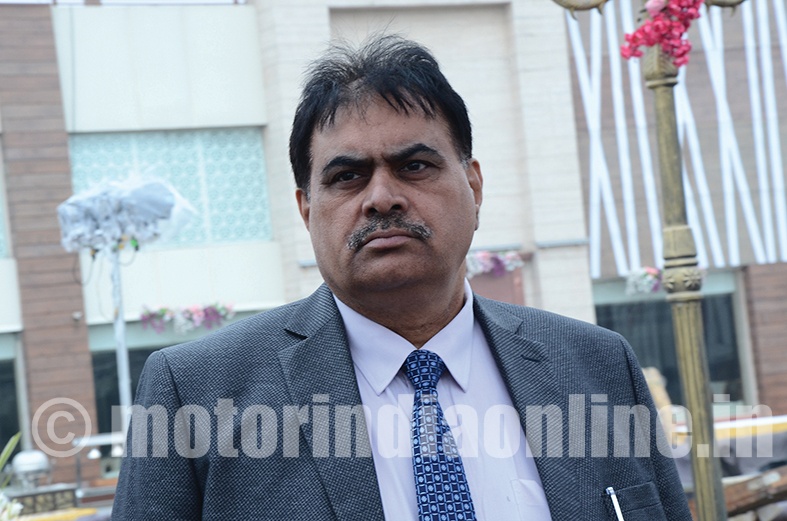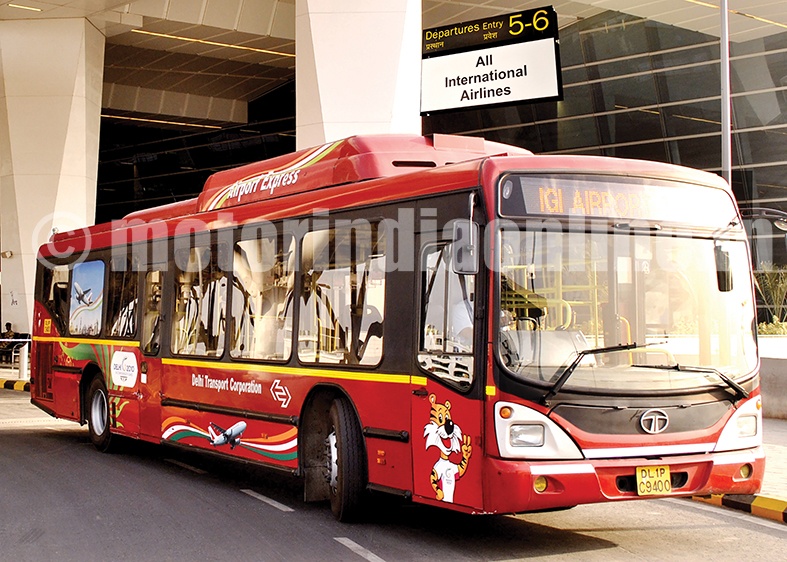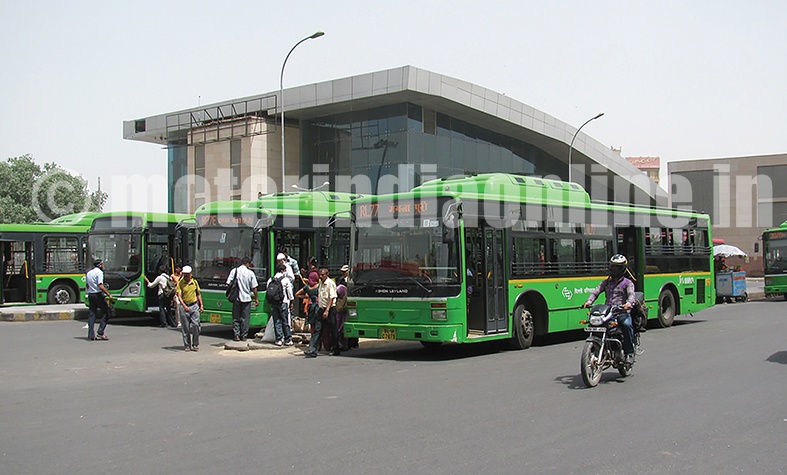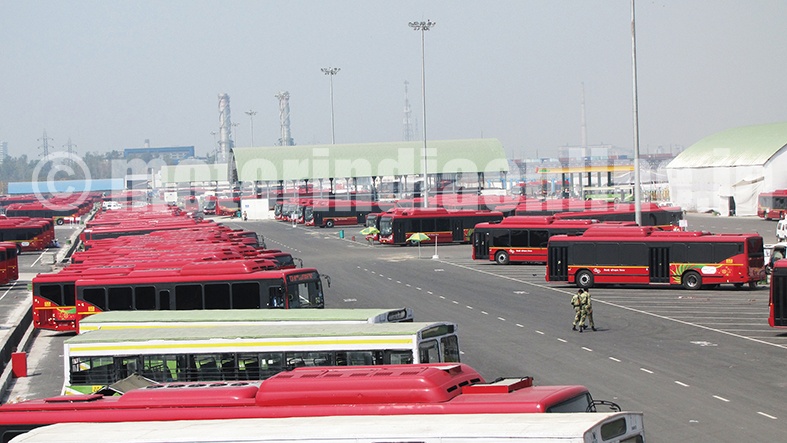Delhi Transport Corporation (DTC), the public transport operator of Delhi, is formulating strategies to go high-tech in its systems and operations in the near to medium term. Being one of the largest CNG-powered bus service operators in the world, it believes that with the embracement of next generation technologies it will not only be thwarting revenue leakages but will also be enhancing the commuting experiencing of its passengers. However, all the technologies will only be incorporated in its conventional buses (low-floor ones) as the older ones (high-floor buses) will be taken off the road in phases. Currently, the State-owned corporation runs a fleet of 4,344 buses (Ashok Leyland and Tata Marcopolo) which are of three kinds, i.e., Standard – 2,506 units (Green Coloured), Air Conditioned – 1,275 (Red Coloured) and Traditional – 563 (older ones).
In an exclusive interaction with MOTORINDIA, Dr. Ravinder Singh Minhas, Deputy Chief General Manager (PR), Delhi Transport Corporation (DTC), stated: “Public Transportation is widely considered as the backbone of any smart city development. I think atleast 50% weightage will be given to sustainable transport with a huge thrust on intelligence systems. Since we are the oldest and the most professional run institution in the capital city, we are hopeful that our corporation will get a major boost. Going forward, Data Monitoring and Analysis can reflect on the performance of buses, routes, crew, depot, and in fact, the overall performance of the bus agency. Thus, the introduction of IT can result in additional revenue generation by retaining commuters and increasing passenger trips.”
Currently having a capacity of 53 (33 sitting and 20) standing per bus, the Delhi-based corporation operates 550 routes in Delhi and around 11 on its outskirts with a maximum speed limit of 40 km/hr. Nearly 3.5 million passengers travel daily by these buses with the average occupancy being 80%. The number of passengers might surge in the wake of the cabinet decision to have a strength of 5,500 buses in DTC’s fleet.

“As soon as the Govt. gives a go ahead, we will be floating our global tender to acquire new buses. Once the new fleet of vehicles is inducted, around 11,000 buses will be plying on Delhi’s roads, out of which 50% will be run by corporates under the cluster scheme by DIMTS and the remaining half by DTC. Atleast 70% of the entire fleet count will be non-AC buses with only 30% being AC run,” as disclosed by Dr. Minhas.
Talking about the strategies to go hi-tech, Dr. Minhas stated: “Our modern fleet of buses, which are low-floor ones, would be equipped with state-of-the-art technologies to guide and monitor them. They will be equipped with Global Position System (GPS) devices so that their movement and geographic location are tracked by the Automatic Vehicle Location System (AVLS) on a real-time basis. Furthermore, Electronic Ticketing Machines (ETM) will be used on all these buses in place of pre-printed tickets being currently used as part of the Automatic Fare Collection System (AFCS), which will also include smartcards in the future.”
To kickstart the whole process of technological evolution, the buses from Rohini Depot-I (110 Nos.) and Rajghat Depot-I (132 Nos.) are equipped with ETMs.
As Dr. Minhas stated: “We have successfully rolled out ETMs at two key depots which is part of the first phase of the project’s implementation. In some other routes too, conductors have started charging fares from passengers through ETMs on a trial basis. The response has been very encouraging and by August’16, all DTC buses should be have e-ticketing machines as our vendor is working on this for all our remaining depots. Once ETMs are installed in all the DTC buses, we will move towards a Common Mobility Card or Smart Card for travelling in both DTC and Metro. We are proactively holding talks with DMRC to work on a common card for both the journeys. This is the last part of installation of ETMs and subject to certain clearances. The tentative date to initiate use of this card is by July end and by the end of this year, you will be able to use a single card for both the modes of transportation. Having said that, we eventually have to go for a Smart Tag System inside buses for cashless travel. Going forward, there would also be a provision for online ticketing for intra-city travel.”
DTC hopes that ETMs will plug revenue leaks that have plagued the agency for decades. As Dr. Minhas pointed out, “ETMs will ensure that operational costs are brought down. The biggest benefit will be in revenue collection, as well as cutting down on ticketless travel by commuters substantially. The ETM will ensure that fares for every ticket sold is accounted for, which at present is done manually.”
Furthermore, DTC has installed three CCTV Cameras in each bus from Sarojini Nagar Depot (100) and Rajghat Depot-I (132) with the cameras having the maximum recording capacity of seven hours. This is in addition to home guards being stationed in many buses to ensure female passenger’s safety. It will also be re-floating a tender for installation of GPS system in all the buses as it is on course to replace the existing devices. As all the DTC buses would be retrofitted with a GPS, the corporation is quite confident that revenue leakage will be tackled as the GPS ensures that buses follow the designated route and don’t miss stops.
“CCTVs on the buses can contribute to commuter safety as well as accident analysis while GPS can help the bus agencies monitor the fleet for adherence to schedules, stop skipping of bus stops during peak hours and check speeding. As a pilot project, we have rolled out surveillance cameras in one of the primary routes of this city. We did install GPS in all our buses earlier but due to some issues with the vendor a very few of them are in a working condition. We will soon be floating another tender for its installation and in due course of time all the buses will be equipped with GPS devices,” revealed Dr. Minhas, adding that the commuters can now avail of the Wi-Fi facilities on three buses plying on Mudrika, Narela, and Airport Express routes. He also added that DTC will soon float tenders to extend this service to other prominent routes.
Meanwhile, DTC is also drawing up plans to roll out a Passenger Information [Display] System (PIS or PIDS) across the city. Very popular in developed countries like the US, France, Brussels, Singapore, Germany, Japan, South Korea, etc., PIS is essentially an electronic information system which provides real-time passenger information about the oncoming bus number along with its arrival and departure times.
As shared by Dr. Minhas: “Just on the lines of metro stations and airports, we are preparing a blueprint for a PIS for buses. It may be used both physically within a transportation hub or remotely using a web browser or mobile device. We are working out modalities wherein you can download the app and get all the information on your smartphone. Those information will also be flashed at the bus stands.”
It is to be mentioned that DTC services in Delhi has a vastly distributed network of bus services and connects almost every part of the city. The most prominent of these is the Mudrika and the Bahri Mudrika Seva services interconnecting all parts of the city with a great frequency of buses until approximately 10:30 p.m. There are also buses on special hire like three buses for IAF. It is also running one electric vehicle on a trial basis which is operating quite well.
Apart from going for technical advancements, DTC is also doing some feasibility study on introducing 24-metre vestibule buses. As Dr. Minhas pointed out, “Whenever the technical department gives a go-ahead, we will go for it. We will go for a global tender and anybody can participate in that. Apart from existing players, new OEMs like JBM, Bharat Benz, Scania, Volvo, etc., are welcome to participate in the bidding process if they are ready to sign Asset Management Contracts (AMCs) with us.”
At present, the average age of its fleet is seven years and will likely to go up to 12 years when new vehicles come in. There are 7,705 drivers on its payroll with another 3,794 ones hired on a contractual basis. Clocking Rs. 3 crore on a daily basis, it is able to achieve an annual turnover of Rs. 1,080 crores. Apart from the farebox amount, it also gets a cushion from the government in the form of a soft loan of Rs. 1,000 crores on a yearly basis. Around 2-3 of the sales turnover is also derived from non-operational business like selling junk (discarded buses), advertisement, unipols at the depots, and wall wraps. Going forward, plans are afoot to generate 10pc of the topline from non-operational business with the growing popularity of digital advertisement.


